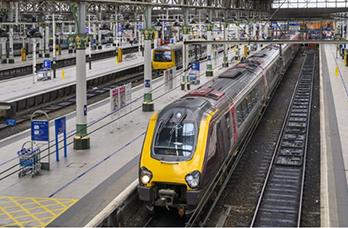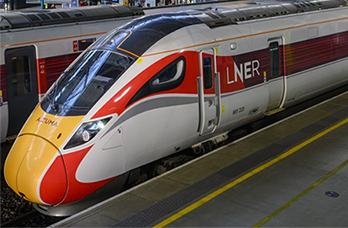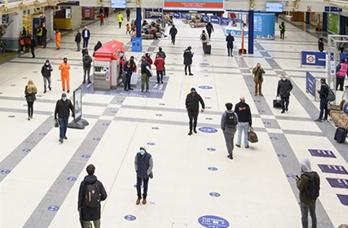Helping the rail industry to achieve health and safety excellence.
About RM3
Developed by the Office of Rail and Road in collaboration with the rail industry, the Risk Management Maturity Model (RM3) encourages organisations to achieve excellence in health and safety management.
The tool is designed to:
- help you manage health and safety risks
- identify areas for continuous improvement, and
- provide a benchmark for year-on-year comparison
RM3 works with your organisation's Safety Management System, setting out criteria for key elements of your approach.
By applying the model you can understand which areas you are performing well at, and others where additional work is needed.
RM3 e-learning
Our online learning platform helps health and safety professionals gain a full end-to-end understanding of how RM3 works and how to apply it to an organisation.
Select the introduction module to get started. At the end of each module you can download a certificate of completion.
If you have any questions, please contact the RM3 team.
Read the RM3 publication
The latest edition is designed to be more accessible to people just starting to use the model, and pushing the boundaries for experienced users.
Topic Set 1 Heritage Railways Collapse accordion Open accordion
We recognise that smaller organisations or those just starting out on the RM3 journey may find some elements of RM3 2019 inaccessible or not obviously relevant to them. To help minor and heritage railways we developed Topic Set 1 Heritage Railways.
Topic Set 1 provides focused descriptors over a much smaller and more readily applicable set of criteria that reflect the sector’s operating characteristics and risk profile. Users should find the additional examples of heritage-centred evidence make it easier to determine maturity levels of their organisation.
We believe this approach makes RM3 more accessible and meaningful as a tool to help organisations identify what they can do to improve the maturity of their safety management system.
The ORR RM3 Assessment Toolkit Spreadsheet Collapse accordion Open accordion
This is an Excel spreadsheet that assists the assessor to determine their level of maturity against each of the 26 RM3 criteria. The spreadsheet has an easy to use evidence matrix to determine the 25 RM3 criteria maturity levels and a separate organisational culture (OC6) assessment matrix. The data from these assessments is automatically populated and represented in radar graph and bar charts for ease of presentation.
The ORR RM3 Heritage Assessment Toolkit Spreadsheet Collapse accordion Open accordion
This is an Excel spreadsheet that assists the assessor to determine their level of maturity against each of the 10 RM3-H criteria. The spreadsheet has an easy to use evidence matrix to determine the 10 RM3-H criteria maturity levels. The data from these assessments is automatically populated and represented in radar graph and bar charts for ease of presentation.
The ORR RM3 Topic Toolkit Spreadsheet Collapse accordion Open accordion
We have developed with industry individual topic toolkit spreadsheets. These will assist the assessor to determine an organisation’s level of maturity against each of the 26 RM3 criteria for a specific risk area or topic, such as change management. Each spreadsheet has an easy to use evidence matrix to determine the 26 RM3 criteria maturity levels. The data from these assessments is automatically populated and represented in radar graph and bar charts for ease of presentation.
RM3 strategy Collapse accordion Open accordion
ORR retains ownership of the Risk Management Maturity Model (RM3) and subordinate documents (e.g. topic sets). To deliver ORR’s objectives for RM3, ORR will:
a) Preserve and strengthen the robustness of the governance of RM3 to provide clarity, direction, and confidence in the future continuity of the model
The ORR chaired RM3 Governance Board (RM3GB) supports ORR in ensuring that RM3 remains relevant to industry. The RM3GB’s Terms of Reference describe the Board’s purpose as facilitating guidance and collaboration between ORR and the rail industry to drive continuous improvement in effective health and safety management maturity.
b) Monitor and evaluate the effectiveness of the model using internal and external sources to ensure continuous development, improvement of the model and enhanced user confidence
By analysing the output from RM3 such as assessments and user feedback, it will provide intelligence on what further development and next steps are needed to the model, ensuring the model is current and supports the needs of the industry. Bi-annual review internal.
c) Define and communicate annual objectives, with measurements and timescales on agreed strategic initiatives
The setting of SMART objectives will provide focus, direction, set expectations, and form a key working pillar of the RM3GB who are required to deliver within set timescales.
d) Enhance the internal process for managing changes to RM3; including the development of topic specific subsets (where appropriate) to compliment RM3 2019
To implement and communicate an agreed framework of how suggested enhancements and improvements to the model are put forward to ensure robust control and effectiveness whilst maintaining quality.
e) Promote, share, and collaborate within the rail sector and other industries on the benefits of measuring the effectiveness of a health and safety management system, and the impact and benefits that RM3 has delivered to the rail industry
An opportunity to share our learnings as a regulator and promote best practice with other industries on how RM3 can be used to improve management system maturity.
f) Standardise and optimise ORR’s application of RM3 with duty holders, ensuring fairness and consistency, whilst supporting ORR’s future strategic planning
Improving the quality and clarity whilst reducing the risk of differing interpretation. It will provide opportunities for innovation to safeguard consistency and fairness.
g) Develop resources for improving the process of conducting and recording the output of RM3 assessments
To explore the opportunity for technological enhancements and integration of the model. The aim is to reduce work process duplication and improve quality of information obtained during inspections, in real time.
h) Intensify user engagement and communication within ORR, building user confidence in the effective use of RM3 during interventions
To strengthen the understanding of the model which will provide consistency on the effective use of RM3. This will improve user confidence, improve two-way communication and feedback leading to future continuous development of RM3.





